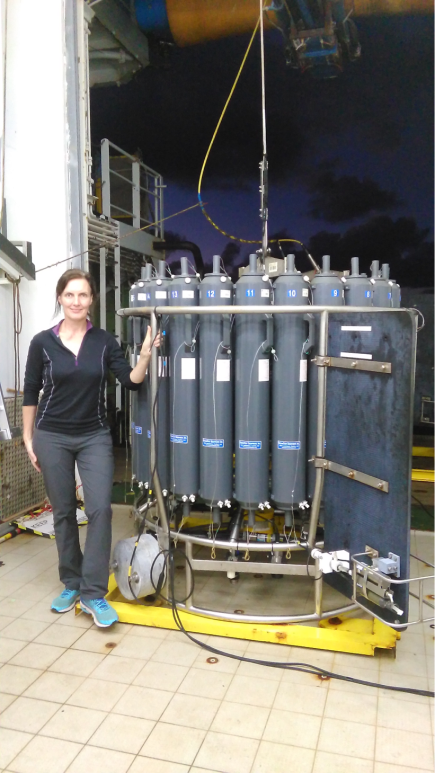The team leader: Prof. Rachel Mills
Prof. Rachel Mills from the University of Southampton is on the Fridge cruise JC156 as the team leader of the stainless-steel rosette. This rosette is used to sample non-trace metal clean elements and to cross calibrate with the Titanium rosette. Normally, following the Titanium Rosette deployment, the first element sampled from this rosette is Helium. Helium is a very good tracer of the hydrothermal input and the best way to track the plume over long distances. This element is then followed by the sampling for Oxygen, Hydrogen Sulfide, Nutrients, Manganese, DNA, Rare Earth Elements and Barium, Protactinium and Thorium, Radium, Neodymium isotopes, Chlorophyll and Salinity. This order is followed because of the time sensitivity of the elements, and the volumes sampled. This rosette is also equipped with an Eh sensor that measures the seawater electopotential relative to a reference electrode (also called oxidation reduction potential sensor). This is provided by Ko-ichi Nakamura from the National Institute of Advanced Industrial Science and Technology in Tsukuba, Japan. This sensor measures the voltage difference between an inert metal electrode (platinum) in the sea water and a standard electrode (silver/silver chloride electrode) in a silver chloride solution (Ref. Interview with Ko-ichi Nakamura by Dan Conrad). The deployment of this sensor is a very useful tool to detect anomalies possibly due to hydrothermal vents as Eh decreases in value in contact of high concentration of reduced species such as Hydrogen, Hydrogen Sulfide, Methane (and some trace metal also).

On the Stainless-Steel Rosette Prof. Rachel Mills also sample for her own research on Neodymium isotopes. A lot of work have been done through GEOTRACES on Neodymium and one of the goals of Rachel Mills on this cruise, is to focus on the processes that take place at the boundary between the vents and the water column. Nd isotopes are a useful tracer for ocean circulation and boundary scavenging processes as their composition varies between different sources in the water column and between seawater and hydrothermal zones. Indeed, in the water column the Nd sources can be dust/river input or other boundary scavenging effects from continental shelf. In hydrothermal zones, this isotope composition can change from different rocks sources (basalt) and even from same rocks in different vents sites. This analysis will also help to understand the effects of the particle-sea water interactions during the early phase of the deep ocean mixing. To do her sampling, Rachel Mills collects between 5 and 7L of water, that are filtered directly from the bottle and then acidified. In parallel she also takes particulate samples from the SAPS to look at the isotopic exchange between the Nd in particulate and in sea water.
Thanks to her previous work on hydrothermal plumes in the North Atlantic, Prof. Rachel Mills main goal on this cruise is to help design the sampling around the plumes to measure the gradient of all trace metal and isotopes.
The Helium samplers: Prof. Ric Williams and PhD student Shaun Rigby
Prof. Ric Williams and PhD student Shaun Rigby, both from University of Liverpool; are in charge of the tritium and helium sampling from the Stainless-Steel Rosette. Aside from the earth’s atmospheric source of helium, there are two sources of helium in the Ocean:
1 – The first source is in shallow water; Hydrogen-3 (Tritium, 3H) is a radioisotope of hydrogen that was introduced to the ocean during nuclear weapon testing in the 1950s and 1960s. Transported with water movement, tritium may be used to understand ocean ventilation. As tritium decays into Helium-3 (3He) with a half-life of 12.5 years, measuring both isotopes allows one to look at the water mass ventilation and provides a measurement of the elapsed time since the water was last at the surface and in contact with the atmosphere. This ventilation timescale is valid on time scales of months to decades. Combining this ventilation age with oxygen data then allows the rates of biogeochemical processes to be diagnosed, such as the rate of apparent oxygen utilisation and carbon export.
2 – The second source is the helium escaping from the magma and being vented into the ocean by hydrothermal activity. This source has a different isotopic ratio, 3He/4He. Mapping the helium stable isotope ratio 3He/4He can reveal the plume transport from hydrothermal vents and the transport pathways for 3He/4He away from the plume.
For our sampling, the helium collection has to be done first as helium is very time sensitive (more volatile than oxygen). To avoid gas loss/exchanges with the atmosphere, the samples are collected in coppers tubes directly connected to the Niskin bottles. The copper tubes are gently hit repeatedly until all bubbles inside the copper pipes are released. The seawater filled tubes are then hydraulically sealed and duplicates obtained. To create a vacuum inside and improve the seal, the pipes are then expended. These samples will be sent to Woods Hole Oceanographic Institute for analysis.
Helium sample collected (first picture) and then sealed in the crimper (second picture) by Shaun Rigby (on the left) and Prof. Ric Williams (on the right) © Lise Artigue
Lise Artigue

